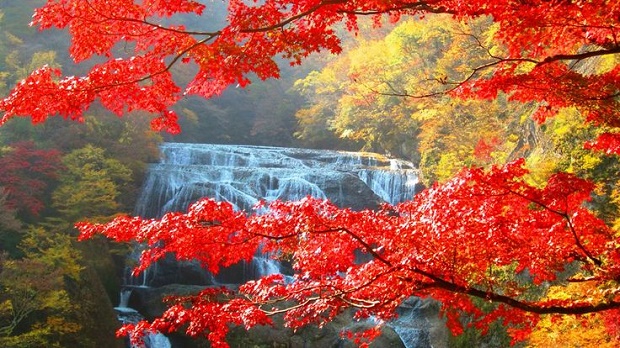Exploring Ibaraki – An Ancient Attraction In Japan
Just an hour by bus or train from Tokyo, Ibaraki perfecture is ideal for a day-trip or an overnight stay. Its historic sites and otherworldly natural beauty attract visitors from far and wide.
FUKURODA WATERFALLS

Considered one of the most spectacular waterfalls in Japan, the Fukuroda Waterfalls measure 73m wide and 120m high and fall over four layers. Each season brings fresh beauty to this spectacular spot. In winter, the falls freeze into magical shapes. In the autumn, mist surrounds the falls. Fukuroda is encircled by numerous hot springs and restaurants that offer traditional foods. Visitors can take a dip in the hot springs and sample the local cuisine.
A GIANT BUDDHA STATUE
The Ushiku Daibutsu is one of the world’s most impressive Buddhist monuments. Weighing 4000 tons, the image is colossal, standing 120m tall, including its 10m base and 10m lotus pfatform. Its left arm measurees 18m, its face 20m, its eyes 2.5m, it nose 1.2m and its ears 10m. Completed in 1993, the bronze statue depicts Amitabha Buddha. It was built to commemorate the birth of Shinran, founder of the “True Pure Land School” of Buddhism. The statue is surrounded by flower gardens. Many festival take place here.
SERENE KASHIMA TEMPLE
Kashima Jingu, or Kashima Temple lies southwest of Ibaraki. The oldest temple in the region, it was constructed in 660 BC in memory of Takemikazuchi, the leader of a school of martial arts. In ancient times, royal families and shogun clans held this temple in high regard. Before marching into battle, Samurais visited the temple to pray for good luck.
Many constructions within the grounds are registered as national cultural sites, including the red-painted tower gate. The surrounding forests are home to rare species of trees and have been nominated for the status of national treasure. Kashima Temple attracts over 600,000 visitors each year and hosts many cultural events and festivals.
PLUM BLOSSOMS IN KAIRAKUEN PARK
Kairakuen Park was opened in 1842 as a leisure spot for both nobles and commoners. Its name comes from a quote in Mencious doctrine: “Ancient people share their joys with humanity, so their joys must have been very genuine and profound”. Kairakuen Park is associated with plum blossoms and is at its loveliest in the early spring, when the pink, white and red plum blossoms are in bloom. The park is also home to spruce trees, bamboo and other species of flora. Senbako Lake to the park’s beauty.
MARTIAL ARTS OF KODOKAN
Kodokan was the largest martial arts school in Japan during the Edo Period, founded in 1841. Many warriors studied martial arts and other subjects in this school. Students enrolled at age 15 and continued to study throughout their lives. Like many other feudal universities, Kodokan boast a breathtaking campus with study halls and Confucian Temples. The samurai spirit nd sense of duty and honor nurtured in this school help to contribute to Japan’s current success.
Visitors to Ibaraki can witness many aspects of Japan’s traditional culture, from tea ceremonies to kimonos and traditional fabric making. This is a great place to shop for local handicrafts.